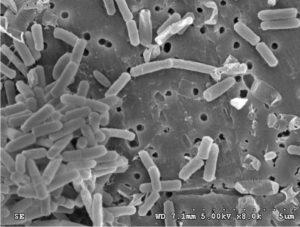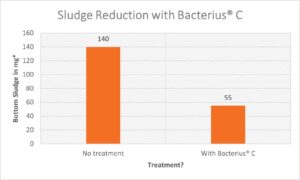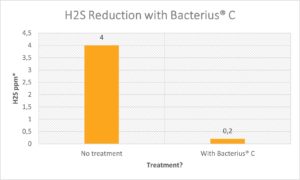Reducing Sludge Through Bio-Augmentation
The most common problem for pond owners is the accumulation of sludge at the bottom of their water bodies. Not only does it make swimming unpleasant and create foul odours, but it’s also a source of several other problems. As mentioned in the article “Cleaning your pond naturally with beneficial microorganisms“, the organic matter that accumulates at the bottom of the water leads to an increase in available nutrients. This increase in nutrients, along with other factors, can lead to an algae bloom in a pond.
« How do you get rid of this smelly and problematic sludge? »
As explained in this article, aeration at the bottom of a pond is a very effective way to reduce organic silt. The use of beneficial bacteria can also remove this sludge. This method is called bio-augmentation.
Bacterius® C, 1B, 5B and MUCK are designed to treat the accumulation of sludge in water bodies. These products ensure the presence of bacteria that will digest organic waste, such as fallen leaves, silt, fish waste, etc.
A bit of scientific data
 In an experiment performed on the product Bacterius® C, it was observed that the addition of these bacteria strains contributed to a faster and more complete degradation of the organic matter in the sludge (including stubborn residues from plant fibres). The remaining sludge was also more compact and “healthier”, because it contained less trapped gas.
In an experiment performed on the product Bacterius® C, it was observed that the addition of these bacteria strains contributed to a faster and more complete degradation of the organic matter in the sludge (including stubborn residues from plant fibres). The remaining sludge was also more compact and “healthier”, because it contained less trapped gas.
Generally speaking, aerobic (i.e. needing oxygen for their metabolism) bacteria such as the ones in Bacterius® C, use organic matter as a source of energy. To be more specific, they digest sludge, cellulose, and proteins by breaking down long chains of molecules into smaller ones that are water soluble. Ultimately, the bacteria convert these byproducts into carbon dioxide and water. This releases energy that is needed for their growth and reproduction.
These results are also demonstrated in the following charts. The first graph shows that the use of Bacterius® C reduced the amount of sludge from 140 mg to 55 mg.

A second observation, made during the experiment and illustrated on the following graph, showed that treated sludge had less H2S (Hydrogen Sulfide) captive gas, making it more compact. Adding Bacterius® C in basins reduced captive gas from 4.0 ppm to 0.2 ppm.

Conclusion and important note!
Bacteria can be found everywhere and they play an essential role in several biochemical cycles. However, sometimes the microbial population is lower than what is needed for a specific result. Therefore bio-augmentation is useful because it compensates for this shortage and ensures the presence of certain bacterial strains in aquatic ecosystems.
Finally, it is also important to note that these bacteria are living organisms, therefore are affected by many environmental factors. So please be aware that their effectiveness, as well as the results obtained from a bio-augmentation treatment, will depend on several other factors specific to your pond or basin, such as the supply of nutrients and organic matter from external sources, the level of dissolved oxygen in the water, the temperature, pH, etc.
Visit our online shop to purchase the Bacterius® C : Shop
Related articles:
Cleaning your pond naturally with beneficial microorganisms
Frequently asked questions about beneficial bacteria
Interesting resource : The Canadian Encyclopedia